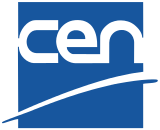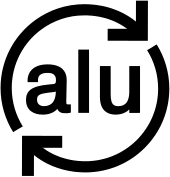European Committee for Standardization
The European Committee for Standardization (CEN, French: Comité Européen de Normalisation) is a public standards organization whose mission is to foster the economy of the European Union (EU) in global trading, the welfare of European citizens and the environment by providing an efficient infrastructure to interested parties for the development, maintenance and distribution of coherent sets of standards and specifications.
Comité Européen de Normalisation Europäisches Komitee für Normung | |
 | |
 Countries in the CEN community | |
| Abbreviation | CEN |
|---|---|
| Type | Regional standards organization |
Region | Europe |
| Website | www |

The CEN was founded in 1961. Its thirty-four national members work together to develop European Standards (ENs) in various sectors to build a European internal market for goods and services and to position Europe in the global economy. CEN is officially recognized as a European standards body by the European Union; the other official European standards bodies are the European Committee for Electrotechnical Standardization (CENELEC) and the European Telecommunications Standards Institute (ETSI).[1][2]
More than 60,000 technical experts as well as business federations, consumer and other societal interest organizations are involved in the CEN network that reaches over 460 million people. CEN is the officially recognized standardization representative for sectors other than electrotechnical (CENELEC) and telecommunications (ETSI). On 12 February 1999, the European Parliament noted in a resolution that CEN, CENELEC and ETSI co-operate smoothly and that a merger of the three standardization bodies would not have clear advantages.[3]
The standardization bodies of the thirty national members represent the twenty seven member states of the European Union, three countries of the European Free Trade Association (EFTA) and countries which are likely to join the EU or EFTA in the future. CEN is contributing to the objectives of the European Union and European Economic Area with technical standards (EN standards) which promote free trade, the safety of workers and consumers, interoperability of networks, environmental protection, exploitation of research and development programmes, and public procurement. An example of harmonized standards are those for materials and products used in construction and listed under the Construction Products Directive. The CE mark is a declaration by the manufacturer that a product complies with all relevant EU directives.
CEN (together with CENELEC) owns the Keymark, a voluntary quality mark for products and services. A product bearing the Keymark demonstrates conformity to European Standards.
Membership
The current CEN Members are:
- all member states of the European Union;
- three of the EFTA members: Iceland, Norway, Switzerland; and
- other states: United Kingdom, North Macedonia, Turkey, Serbia.[4]
The current affiliates are Albania, Armenia, Azerbaijan, Belarus, Bosnia and Herzegovina, Egypt, Georgia, Israel, Jordan, Lebanon, Moldova, Montenegro, Morocco, Tunisia and Ukraine.[5]
The current partner standardization bodies are Australia, Mongolia, Kazakhstan.[6]
Vienna Agreement
The Vienna Agreement was signed by CEN and the International Organization for Standardization (ISO) in 1991 but came in force in the mid-2000s. Its primary aim is to avoid duplication of (potentially conflicting) standards between CEN and ISO. In the last decade CEN has adopted a number of ISO standards which replaced the corresponding CEN standards.[7]
See also
- ANEC (organisation), the European consumer voice in standardization
- CENELEC is the European Committee for Electrotechnical Standardization.
- Ecma International
- ETSI
- Institute for Reference Materials and Measurements
- International Organization for Standardization
- List of EN standards
- List of CEN technical committees
- Eurocodes
References
- Council Directive 83/189/EEC of 28 March 1983 laying down a procedure for the provision of information in the field of technical standards and regulations. Official Journal of the European Communities. 26 April 1983. This directive only recognizes CEN and CENELEC as European standards institutions. Accessed 2009-04-27.
- See Annex 1 of Directive 98/34/EC of the European Parliament and of the Council of 22 June 1998 laying down a procedure Archived 11 May 2011 at the Wayback Machine. Official Journal of the European Communities. 21 July 1998. Accessed 2009-04-27.
- European Parliament: Resolution on the report from the Commission to the Council and the European Parliament 'Efficiency and Accountability in European Standardisation under the New Approach'(COM(98)0291 − C4-0442/98). Official Journal of the European Communities 12 February 1999. Other language versions can be accessed from European Commission: Directorate General Enterprise and Industry: Standardisation Archived 2009-05-28 at the Wayback Machine. Accessed 2009-04-27.
- "CEN members". Cen.eu. Retrieved 27 August 2012.
- "CEN affiliates". Cen.eu. Retrieved 7 December 2015.
- "CEN partner standardization bodies". Cen.eu. Retrieved 27 August 2012.
- G. Malcorps, I. Quintana-Soria (2007). The Vienna Agreement – CEN as an International Partner (PDF). CEN StandarDays (Day 2 –Session 5). CEN.
External links
- European Committee for Standardization
- European Commission: Enterprise and Industry: European standards: European Union standards policy homepage
- W3J.Com: EN Standards The list of all EN (CEN) published standards. (Not complete)
- NORMAPME The European Office of Crafts, Trades and Small and Medium-sized Enterprises for Standardisation
- Sample of certifications for Playground equipment safety